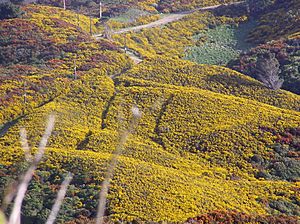Gorse in New Zealand facts for kids
Gorse (scientific name: Ulex europaeus) is a spiky green bush. It was brought to New Zealand a long time ago by early European settlers. Today, gorse is a big problem. It's an invasive plant, meaning it spreads quickly and harms native plants. Millions of dollars are spent each year trying to control it.
Contents
How Gorse Came to New Zealand
Gorse came from Western Europe. It arrived with the first European settlers in New Zealand. Even famous scientist Charles Darwin saw it growing here in 1835. He noted it in hedges in the Bay of Islands.
Gorse spread very fast in New Zealand's mild climate. But early settlers did not see it as a threat. They kept bringing in gorse seeds. People even planted gorse on purpose until the early 1900s.
What Gorse Was Used For
Gorse has been used for many things. Since the 1850s, farmers on the Canterbury Plains used it. They planted gorse to make hedges and windbreaks. These long rows of gorse helped protect farms from strong winds. Together, these windbreaks stretch for 300,000 kilometres!
Gorse can also act like a "nursery" for native plants. Young gorse bushes grow very thick and dense. As they get older, they become more open. This creates perfect spots for native seeds to sprout and grow.
Native seedlings grow up through the gorse. They block the sunlight from the gorse plants. Eventually, the native plants take over and replace the gorse. This method works well at Hinewai Reserve on Banks Peninsula.
Why Gorse is a Problem
Gorse spread widely across New Zealand. By the late 1940s, it covered huge areas. People started to see it as a problem early on. In 1861, the Nelson Provincial Council tried to stop gorse planting.
Gorse seeds can sleep in the ground for up to 50 years. They sprout quickly after adult gorse plants are removed. Sadly, many ways to remove gorse, like burning or bulldozing, make it easier for new seeds to grow. This makes it very hard to get rid of gorse completely.
Gorse is now one of New Zealand's most common farm weeds. It covers about 700,000 hectares. This is about 5% of New Zealand's land area, not counting forests or mountains. By the early 1980s, gorse was the most expensive weed to control. It cost about $22 million every year.
Controlling Gorse with Nature
Scientists are looking for ways to control gorse using nature. This is called biological control. It means using living things, like insects, to fight the gorse.
Since the 1920s, scientists have released seven different insects in New Zealand. These insects eat gorse seeds or leaves. The results have been mixed. So far, these insects alone are not enough to control gorse completely.
Scientists are still working on new ideas. They are trying to manage the insects better. They are also trying to create a special natural spray called a bioherbicide.




